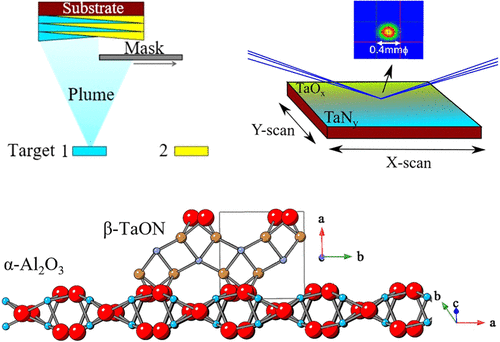当前位置:
X-MOL 学术
›
ACS Appl. Electron. Mater.
›
论文详情
Our official English website, www.x-mol.net, welcomes your feedback! (Note: you will need to create a separate account there.)
Combinatorial Approach for Single-Crystalline TaON Growth: Epitaxial β-TaON (100)/α-Al2O3 (012)
ACS Applied Electronic Materials ( IF 4.7 ) Pub Date : 2020-10-28 , DOI: 10.1021/acsaelm.0c00622 K. V. L. V. Narayanachari 1 , D. Bruce Buchholz 1 , Elise A. Goldfine 1 , Jill K. Wenderott 1 , Sossina M. Haile 1 , Michael J. Bedzyk 1, 2
ACS Applied Electronic Materials ( IF 4.7 ) Pub Date : 2020-10-28 , DOI: 10.1021/acsaelm.0c00622 K. V. L. V. Narayanachari 1 , D. Bruce Buchholz 1 , Elise A. Goldfine 1 , Jill K. Wenderott 1 , Sossina M. Haile 1 , Michael J. Bedzyk 1, 2
Affiliation

|
The photocatalyst β-TaON is of interest due to promising properties, such as stability, suitable band gap for visible light, and carrier mobility. We implemented a combinatorial, material discovery approach that used pulsed laser deposition (PLD) for thin-film growth, X-ray diffraction (XRD) for phase determination, and machine learning for data reduction. A lateral compositional gradient of TaOxNy was grown across the surface of an α-Al2O3 (012) wafer. After annealing, XRD scattering patterns were collected across the lateral gradient. Unsupervised machine learning separated the XRD data into four clusters (phases); one of which turned out to be the desired monoclinic β-TaON phase. Using high-resolution XRD, we determined that the β-TaON region of the film was a 260 Å thick single-crystal epitaxial with the substrate, having out-of-plane β-TaON (100)//α-Al2O3 (012) and in-plane β-TaON (010)//α-Al2O3 (21̅0). X-ray reflectivity (XRR) analysis of the β-TaON region of the film showed an electron density matching that expected for β-TaON. X-ray photoelectron spectroscopy (XPS) showed a Ta5+ valence state in the β-TaON region of the film. This combinatorial approach, which produces a library of phases on a single wafer, proved to be very efficient for the growth of a material’s phase of interest.
中文翻译:

用于单晶生长TAON组合方法:外延β-TAON(100)/α-Al系2 ö 3(012)
由于有希望的性质,例如稳定性,可见光的合适带隙和载流子迁移率,光催化剂β-TaON是令人关注的。我们实施了一种组合的材料发现方法,该方法使用脉冲激光沉积(PLD)进行薄膜生长,使用X射线衍射(XRD)进行相确定以及使用机器学习进行数据缩减。横向组分梯度的的TaO X Ñ ý被跨越的表面生长的α-Al 2 ö 3(012)晶片。退火后,沿横向梯度收集XRD散射图。无监督机器学习将XRD数据分为四个集群(阶段);结果证明其中之一是所需的单斜β-TaON相。使用高分辨率XRD,我们确定膜的β-TAON区域是一个260埃厚的单晶外延与衬底,具有外的平面β-TAON(100)//的α-Al 2 ö 3(012)和面内β-TAON(010)//的α-Al 2 ö 3(210)。膜的β-TaON区域的X射线反射率(XRR)分析显示,电子密度与β-TaON所期望的匹配。X射线光电子能谱(XPS)显示Ta 5+薄膜的β-TaON区域的化合价态。这种组合方法可在单个晶片上产生相库,事实证明,这种方法对于生长所关注材料的相非常有效。
更新日期:2020-11-25
中文翻译:

用于单晶生长TAON组合方法:外延β-TAON(100)/α-Al系2 ö 3(012)
由于有希望的性质,例如稳定性,可见光的合适带隙和载流子迁移率,光催化剂β-TaON是令人关注的。我们实施了一种组合的材料发现方法,该方法使用脉冲激光沉积(PLD)进行薄膜生长,使用X射线衍射(XRD)进行相确定以及使用机器学习进行数据缩减。横向组分梯度的的TaO X Ñ ý被跨越的表面生长的α-Al 2 ö 3(012)晶片。退火后,沿横向梯度收集XRD散射图。无监督机器学习将XRD数据分为四个集群(阶段);结果证明其中之一是所需的单斜β-TaON相。使用高分辨率XRD,我们确定膜的β-TAON区域是一个260埃厚的单晶外延与衬底,具有外的平面β-TAON(100)//的α-Al 2 ö 3(012)和面内β-TAON(010)//的α-Al 2 ö 3(210)。膜的β-TaON区域的X射线反射率(XRR)分析显示,电子密度与β-TaON所期望的匹配。X射线光电子能谱(XPS)显示Ta 5+薄膜的β-TaON区域的化合价态。这种组合方法可在单个晶片上产生相库,事实证明,这种方法对于生长所关注材料的相非常有效。



























 京公网安备 11010802027423号
京公网安备 11010802027423号